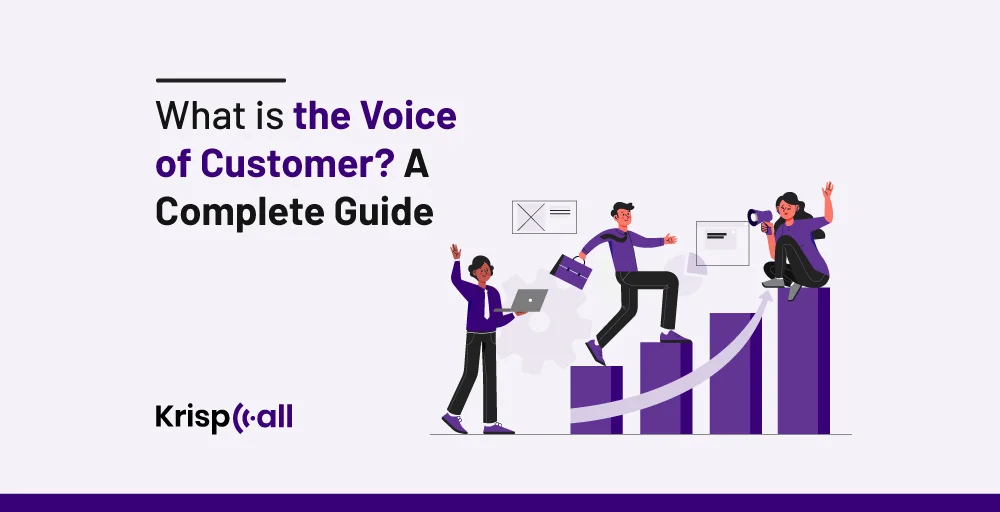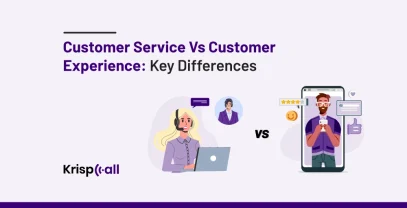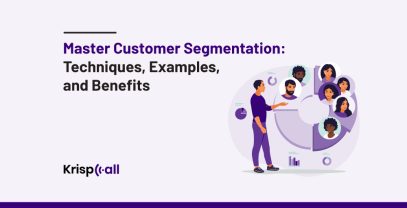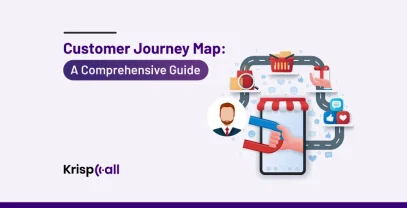Are you frustrated with not knowing what your customers expect from your business and want to meet their needs and expectations to gain reliable insights? 🤔
Customer needs, preferences, opinions, and feedback are not just important; they are the lifeblood of success in today’s competitive business market. One effective method of collecting and utilizing this crucial data information is by using Voice of the Customer. 🗣️
In this guide, we’ll discuss the Voice of Customer (VoC), its importance in the business, the types of VoC, and how to maximize it to fuel business growth and customer satisfaction.
🔑 KEY HIGHLIGHTS
- Voice of the Customer (VoC) refers to customer feedback regarding their experiences with and expectations for your products or services.
- Surveys, Interviews, Reviews, NPS, etc., are commonly known VoC types and methodologies.
- Voice-of-customer questions are asked to the customer to gain more insight regarding their opinion towards a particular product or service.
- VoC data provides valuable input for marketing strategies, helping businesses re-craft their messaging to target the right audience.
What is Voice of Customer?

Voice of Customer (VoC) refers to customer feedback regarding their experiences with and expectations for your products or services. It involves collecting and analyzing data from customers’ feedback, opinions, and preferences regarding the products and services any business offers. This helps to gain insights into customers’ needs, expectations, experiences, and issues.
By paying attention to the voice of the customer, businesses can acknowledge their customers’ perspectives and figure out areas for improvement. VoC is valuable in improving products or services, enhancing customer satisfaction, and increasing business growth. VoC helps make data-centric decisions and plans to meet customer expectations and needs.
Why is Voice of Customer Important?
VoC plays a vital role in enhancing the customer experience of any business. Some of the significance of VoC for businesses include:
- Consumer-based decision-making: VoC gives valuable information and data on customers’ requirements, opinions, and pain points, allowing businesses to make decisions that align with customer expectations and needs. Customer-centric decision helps companies to increase customer loyalty and retention rates.
- Product and service improvement: By acknowledging customer feedback, businesses can identify areas for improvement in their products or services. Companies can reduce customer churn by addressing customer demand and improving satisfaction, leading to higher revenues and profitability.
- Competitive advantage: By continuously gathering and analyzing customer feedback, businesses can stay ahead of competitors by identifying emerging trends, market gaps, and customer demand. They can also help build a positive brand reputation and increase customer trust.
- Data-Driven Marketing: VoC data provides valuable input for marketing strategies, helping businesses re-craft their messaging, target the right audience, and create more compelling ad campaigns that resonate with customers’ demands.
Types of Voice of Customer
Some well-known and familiar types of Voice of Customer (VoC) are:
- Interview: In the context of Voice of Customer (VoC), an interview denotes direct conversations between a company representative and a customer. The interviewer typically asks specific questions to gather information about customer’s experiences, preferences, needs, and opinions regarding the company’s products or services.
- Net Promoter Score (NPS) Surveys: Net Promoter Score is a metric used to measure customer loyalty and satisfaction. It is based on the likelihood of customers recommending a company’s product or service to others. In NPS, customers are categorized into promoters, neutrals, and detractors.
- Surveys: Surveys are structured questionnaires designed to collect customer feedback and opinions. They typically include a range of questions covering different areas of the customer experiences, such as satisfaction levels, preferences, suggestions for improvement, and complaints.
- Reviews: Reviews are one of the easily recognized types of VoC. It refers to customer opinions and feedback about a company’s services or products. Customer reviews can provide valuable insights into a business’s strengths and flaws from the customer’s perspective.
What are the Voices of Customer Questions to ask?
The average attention span of any human being is 3-4 minutes. Asking the interactive and anticipating questions is very important to know the voice of the customer.
Don’t worry—we have covered it all. Here are some of the best voice-of-customer survey questions to ask.
- How likely are you to refer (Company or brand name, product or service) to a friend, family member, or colleague?: This question helps determine the customer’s loyalty towards a particular brand or product. Asking these close-ended questions lets you get exact information for your data analysis. 6
- How likely will you switch to another company when purchasing (product or service) in the next six months?: This question helps you gain insights for calculating churn and retention rates and make plans based on what customers want to reduce the churn rate.
- What factor matters most when selecting a company for (Product or service name)?:
This open-ended question helps you make strategies and plans for your product development and campaigns by knowing customers’ market demand and buying factors. - Which of the following social media platforms do you use every week?: This simple yet powerful question helps you know where your targeted audience spends their most time. You are making it easier to create ads and promote your product or service, mainly on platforms with high chances of conversion.
How Do You Measure the Voice Of The Customer?

There are different ways to measure the Voice of Customers, as given below:
1. Customer support interactions
You can analyze calls, emails, and chat transcripts from your customer support team. After completing the analysis, you can pinpoint common problems, areas of commendation, and the general sentiment conveyed by customers during interactions.
2. Customer feedback channels
Most businesses provide dedicated feedback channels such as surveys, forums, or social media groups. Then, you can regularly ask for feedback through these channels and study the responses to grasp how customers feel and how satisfied they are.
3. App and website analytics
User behavior data from your app or website is essential since you can track user journeys, page views, and time spent on the site, identify pain points, and see where customers drop off. These detailed data reveal areas for improvement and inform efforts to address customer frustrations.
4. Net promoter score (NPS)
This metric allows you to measure customer loyalty. You can conduct NPS surveys to ask customers how likely they are to recommend your business to their friends, family, and others. The net promoter score reveals enthusiastic fans, neutral customers, and unhappy customers.
5. Customer Reviews
Monitoring online reviews on platforms like Yelp, Google Reviews, and social media channels can provide valuable insights into customer sentiment. Analyzing these reviews and comments can help identify trends, joint issues, and areas for improvement.
What is Voice Of Customer Program?
The Voice of the Customer (VoC) program is the process of recording and analyzing feedback, preferences, and opinions about a product, service, or brand. It is mainly used in business, marketing, and customer service. It involves collecting information directly from the consumers via different channels such as surveys, interviews, social media, and support interactions.
The factors you need to focus on while building a VOC program are
- Robust Leadership,
- Strong Vision & Clarity,
- Collaboration & Engagement,
- Better Listening & Learning,
- Alignment & Acts,
- Patience & Dedication
Voice of Customer Best Practices

The Voice of the Customer (VOC) program’s benefits can only be fully utilized with effective VoC practices. Here are some of the best practices you need to follow:
1. Define objectives
You need clear goals to achieve, whether boosting customer satisfaction, raising sales, or improving the overall customer experience. Having a clear objective of what you want to accomplish with your VoC program will guide your efforts and give good results.
2. Use of different VoC methodologies
Quantitive and qualitative methods of collecting VoC data are essential to get more accurate data. Surveys, Interviews, NPS, CSAT(customer satisfaction score), etc.) are examples of VoC methods.
3. Collection and Data Analysis
Collecting data regularly ensures you have up-to-date censure customer information. Collected data helps you look for trends, patterns, and interrelations to understand the primary reason behind customer opinion.
4. Work on Feedback
Using VoC data to ignite decision-making, taking actions based on customer feedback, and informing the clients about the changes you are making based on their feedback will show that you value their input. Always prioritize the feedback based on its impact on the business.
5. Backtracking Progress
VoC is an everlasting process that needs to be modified by trends and customer feedback. You should always keep track of your results and indicators from NPS, CSAT, and other VoC methods. Backtracking will help you adapt effectively to evolving customer needs and market fluctuations.
Conclusion
The Voice of the Customer is a vital ideology and tool for companies looking to succeed in today’s competitive business market. It captures and analyzes customer feedback through various methodologies, such as Interviews, NPS, CSAT, Surveys, etc. By applying VoC to the business model, businesses can build more robust bonds with customers and stay competitive.
VoC is more about listening to, understanding, and acting on the customer’s feedback rather than just hearing what they say. Applying VoC and sticking with the changes that need to be done will bring positive change and provide a better experience that keeps the consumers coming back.
FAQs
What is the Voice of the Customer’s role in customer success?
Customers are the pillar for any business to bloom, and the Voice of the Customer is crucial for customer success. VoC serves as a base for building strong customer relationships. Understanding VoC guides businesses to enhance overall customer experience.
What is VoC Six Sigma?
Six Sigma survey is a data-driven process improvement methodology that lowers process timelines and failures. When a VoC program is operated with the Six Sigma model of the survey, it is called VoC Six Sigma. It highlights the importance of understanding and incorporating customer requirements into process improvement efforts.
What are VoC Tools?
VoC tools help businesses gather information from different methodologies, such as surveys, customer support groups, online reviews, and interviews. VoC tools often include text analytics, customer distribution, emotion-based analysis, and reporting ability to help businesses better understand and act on customer feedback. Some popular VoC tools include Medallia, SurveyMonkey, Qualtrics, and Zendesk.





